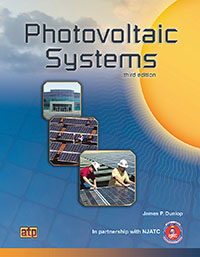Photovoltaic Systems, 3rd edition 2014
| Photovoltaic Systems By: In partnership with NJATC | ||
|
Photovoltaics, along with other renewable-energy technologies, is a rapidly growing sector of the energy market. Photovoltaic Systems is a comprehensive guide to the design, installation, and evaluation of residential and commercial photovoltaic (PV) systems. The textbook covers the principles of photovoltaics and how to effectively incorporate PV systems into stand-alone or interconnected electrical systems. The content includes system advantages and disadvantages, site evaluation, component operation, system design and sizing, and installation requirements and recommended practices. Common scenarios and procedures are discussed throughout. Specified electrical requirements are in accordance with the National Electrical Code®. |





